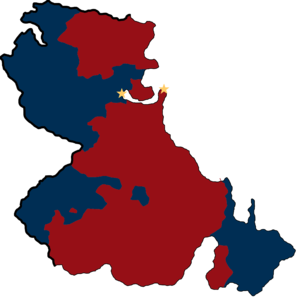Quebecshirite Civil War
| Quebecshirite Civil War | |||||||
|---|---|---|---|---|---|---|---|
 Map of the civil war in 1623. The Monarchists are in blue and the Republicans in red. | |||||||
| |||||||
| Belligerents | |||||||
| Supported by:Reykani Commonwealth | 23px Monarchists | ||||||
| Commanders and leaders | |||||||
|
23px Arsène Champlain 23px Marc Johnson † 23px Jacques Bourassa 23px Jean Mossé 23px Enzo Levasseur † |
23px Yvon Delsarte 23px Roland Rodier 23px Lambert Lafayette † | ||||||
| Strength | |||||||
|
~102,952 soldiers | ~107,275 soldiers | ||||||
| Casualties and losses | |||||||
|
34,328 killed or missing 24,685 wounded or sick |
28,945 killed or missing 32,578 wounded or sick | ||||||
|
143,273 total killed or missing 96,263 wounded or sick | |||||||
The Quebecshirite Civil War was a civil armed conflict which raged from April 26, 1607 to December 17, 1623 in Quebecshire between the Monarchist Coalition for the Reunification of Quebecshire (CMRQ, Monarchists) and the Quebecshirite Republican Assembly (ARQ, Republicans). The war ended in a ceasefire in 1623 beginning the Orléans Negotiations.
The civil war began when the minimally effective federalized democracy failed as the Congress of the Cantons was unable to handle economic downturn or properly facilitate the internal distribution of resources. Major battles were fought in the northern mountains and the mid-section of the nation in order to control natural resources and agriculture. Several battles were fought in the bay around Quebecshire City, Bostonia, and Orléans.
Quebecshire City became the major base of operations for the Monarchists, whereas the Republicans set up their functions from Bostonia. The Monarchists were able to eventually force the Republicans out of most of the southeastern peninsula, nonetheless the Republicans held strong in the midlands and many maritime locations. Due to this Monarchist progress was largely slowed.
In 1620 large-scale fighting decreased and the conflict was almost entirely reduced to border skirmishes. Eventually, the separate provisional governments began to struggle due to lack of resources for the Republicans and a lack of trade opportunities for the Monarchist groups. In 1623, a ceasefire (but not reunification) agreement was made by the Monarchist Coalition for the Reunification of Quebecshire (CMRQ) and the Quebecshirite Republican Assembly (ARQ) to begin negotiations in Orléans on March 4th, 1623.
After about eight months (December 17th, 1623), an agreement for the basis of a new Constitution was reached. Both the CMRQ and the ARQ ratified the agreement and began the re-integration of the opposing sides. The Quebecshirite National Reorganization Council (CNRQ) was formed following this arrangement to provisionally reunify Quebecshire before the High Council and Parliaments of Quebecshire could be set up and have their offices filled. The Declaration of the Establishment of a New Constitution for a Unified Quebecshirite State generally entailed the following list contents. The conclusion of the Civil War also led to the creation of the Quebecshirite political philosophy of Revanchism, which is still prominent.
International intervention
After the outbreak of the war 5 years later in 1612 the Reykani Commonwealth joined the war on the Republican side. Reykanes sent equipment and aid to the republicans to help their war support. It was in Reykanes's interest that they win as to get a potential new ally. This was done as to stabilize the region as well, since Quebeschire is a important major nation in the region. By 1617 Reykanes sent 400 volunteers to help out as out to change the tide. They would be helping out in the upcoming battles. The Navy was set around the coast if help was needed.